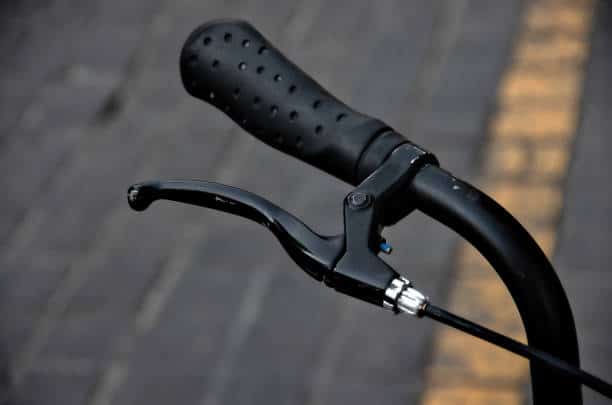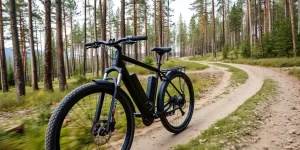Introduction
Electric bicycles, or e-bikes, have revolutionized the way people commute and enjoy recreational cycling. As e-bikes continue to gain popularity, it is crucial for riders to understand the importance of one of the most critical components: the brakes.
E-bike brakes are responsible for ensuring a safe and controlled riding experience, especially considering the increased speeds and weight of electric bicycles compared to traditional bikes. In this comprehensive guide, we will take an in-depth look at the world of e-bike brakes, exploring the different types, their advantages and disadvantages, maintenance requirements, and safety considerations.
By the end of this article, you will have a thorough understanding of how to choose, maintain, and use your e-bike brakes for optimal performance and safety.
WHAT ARE THE Types of E-Bike Brakes?
There are two primary types of e-bike brakes: mechanical disc brakes and hydraulic disc brakes. Both systems utilize a disc rotor attached to the wheel hub and brake pads that clamp onto the rotor to slow down or stop the bike.
However, the way they operate and their performance characteristics differ significantly.
Mechanical Disc Brakes
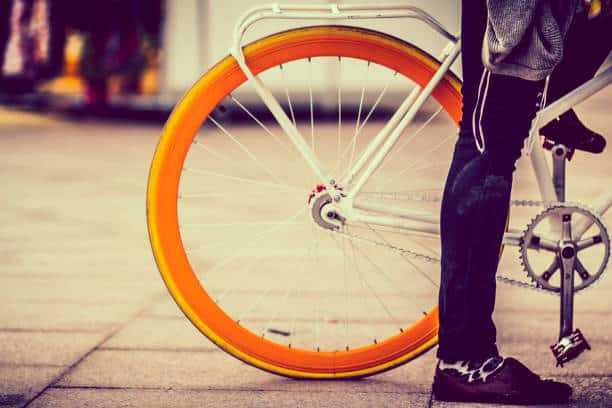
Mechanical disc brakes, also known as cable-actuated disc brakes, use a steel cable connected to the brake lever to mechanically push the brake pads onto the rotor.
When the rider squeezes the brake lever, the cable pulls on the caliper arm, forcing the brake pads to clamp down on the rotor. This creates friction between the pads and the rotor, slowing the wheel’s rotation.
Advantages of mechanical disc brakes:
- Lower cost: Mechanical disc brakes are generally less expensive than their hydraulic counterparts, making them a more budget-friendly option for e-bike riders.
- Easier maintenance: The simpler design of mechanical disc brakes makes them easier to maintain and repair. Riders can often adjust cable tension and replace brake pads without special tools or expertise.
- Compatibility: Mechanical disc brakes are compatible with a wide range of brake levers and handlebars, making them a versatile choice for e-bike builders and customizers.
- Field serviceability: In the event of a breakdown or malfunction, mechanical disc brakes can be more easily repaired on the trail or road, as they do not require bleeding or specialized knowledge.
Disadvantages of mechanical disc brakes:
- Frequent adjustments: Due to cable stretch and wear, mechanical disc brakes require more frequent adjustments to maintain optimal performance. This can be inconvenient for riders who prefer a “set-and-forget” braking system.
- Reduced power and modulation: Compared to hydraulic disc brakes, mechanical disc brakes typically offer less braking power and modulation. This means that riders may need to apply more force to the lever to achieve the same stopping power, and it may be more difficult to control the braking force precisely.
- Cable friction: The steel cables used in mechanical disc brakes are subject to friction within the housing, which can reduce braking efficiency and feel. This friction can also increase over time as the cables and housing wear.
- Increased weight: Mechanical disc brake systems, including the cables and housing, are generally heavier than hydraulic systems. This added weight can be a consideration for riders looking to minimize the overall weight of their e-bike.
Hydraulic Disc Brakes
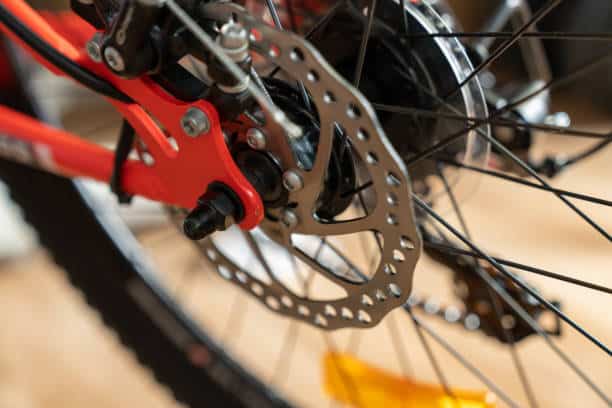
Hydraulic disc brakes use a sealed fluid system to transfer force from the brake lever to the caliper. When the rider squeezes the brake lever, it pushes a piston in the master cylinder, pressurizing the brake fluid.
This pressure is then transmitted through the hydraulic hose to the caliper, where it forces the brake pads onto the rotor.
Advantages of hydraulic disc brakes:
- Superior braking power: Hydraulic disc brakes offer significantly more braking power than mechanical disc brakes. This is due to the high pressure generated in the fluid system, which allows for greater clamping force at the rotor.
- Improved modulation: The sealed fluid system in hydraulic disc brakes allows for better modulation, meaning riders can more precisely control the amount of braking force applied. This is especially useful in technical riding situations or when navigating slippery surfaces.
- Adjusting Cable Tension: As brake pads wear, hydraulic disc brakes automatically adjust to maintain optimal pad contact with the rotor. This reduces the need for frequent manual adjustments.
- Consistent performance: Hydraulic disc brakes maintain consistent performance across a wide range of temperatures and weather conditions. They are less affected by cable contamination or stretching, which can degrade the performance of mechanical disc brakes over time.
- Lighter weight: Hydraulic disc brake systems are typically lighter than mechanical systems, as they do not require heavy cables and housing. This weight savings can be beneficial for riders looking to maximize the efficiency of their e-bike.
Disadvantages of hydraulic disc brakes:
- Higher cost: Hydraulic disc brakes are generally more expensive than mechanical disc brakes due to their more complex design and precision components. This can be a significant consideration for budget-conscious e-bike buyers.
- Complexity: The sealed fluid system in hydraulic disc brakes is more complex than the cable-actuated system in mechanical brakes. This complexity can make hydraulic brakes more challenging to maintain and repair, often requiring specialized knowledge and tools.
- Potential for fluid leaks: In the event of damage or wear to the hydraulic system, brake fluid can leak, leading to reduced braking performance or complete failure. Leaks can be difficult to diagnose and repair, especially for riders without prior experience working on hydraulic brakes.
- Temperature sensitivity: While hydraulic disc brakes generally perform well in a wide range of conditions, extreme temperatures can affect the brake fluid’s performance. In very cold weather, the fluid may thicken, reducing braking responsiveness. In high-heat situations, such as prolonged downhill braking, the fluid may boil, leading to a temporary loss of braking power.
Brake Components and Terminology
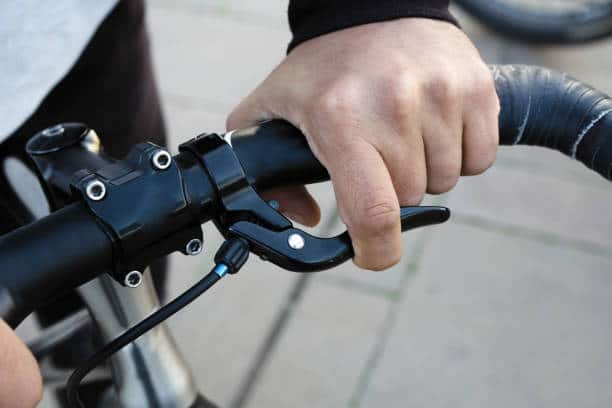
To better understand e-bike brakes, it’s essential to familiarize yourself with the various components and terminology associated with these systems.
Brake Pads
Brake pads are the consumable components that press against the rotor to create friction and slow the wheel. They are available in different materials, each with its own characteristics:
- Organic pads: Made from a mixture of materials, including kevlar, resin, and rubber. They offer good initial bite and are quieter than metallic pads but wear faster and may fade under heavy use. Organic pads are best suited for casual riding in dry conditions.
- Sintered metallic pads: Composed of metallic particles bonded together under high pressure. They provide excellent heat dissipation and durability, making them ideal for heavy-duty use and wet conditions. However, sintered pads can be noisy and require a longer break-in period to achieve optimal performance.
- Semi-metallic pads: A compromise between organic and sintered pads, offering a balance of performance, durability, and noise levels. Semi-metallic pads are a good choice for riders who want the benefits of both organic and sintered pads without the drawbacks of either.
When selecting brake pads, consider your riding style, terrain, and weather conditions to choose the most suitable option for your needs.
Brake Calipers
The brake caliper is the component that houses the brake pads and pistons (in hydraulic systems) or the cable-actuated mechanism (in mechanical systems).
Calipers are mounted to the frame or fork and align with the rotor to ensure proper pad contact.Calipers come in different designs, such as post-mount or flat-mount, which refer to the way they attach to the frame or fork.
Post-mount calipers bolt directly to the frame or fork, while flat-mount calipers use an adapter to provide a lower profile and more aerodynamic installation.
Calipers can also have varying numbers of pistons, usually 2 or 4, which affect the braking power and heat dissipation. More pistons generally provide greater clamping force and better heat management, making them suitable for heavier e-bikes or more demanding riding conditions.
Brake Levers
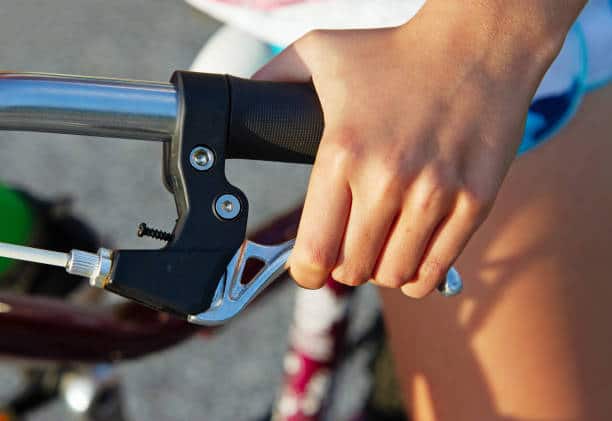
Brake levers are the controls mounted on the handlebars that allow the rider to engage the brakes. They come in different styles and sizes to accommodate various hand sizes and preferences.
- Short-pull levers: Designed for use with mechanical disc brakes, short-pull levers have a shorter cable pull and are compatible with a wide range of caliper designs.
- Long-pull levers: Also known as V-brake levers, these are designed for use with linear-pull brakes and have a longer cable pull than short-pull levers. Some mechanical disc brake calipers are compatible with long-pull levers, but it’s essential to check compatibility before installation.
- Hydraulic levers: Designed specifically for use with hydraulic disc brakes, these levers feature an integrated master cylinder that pressurizes the brake fluid when squeezed.
Many brake levers also offer adjustable reach, allowing riders to customize the distance between the lever and the handlebar to suit their hand size and preferences. This ensures a comfortable and secure grip, even during long rides or challenging terrain.
Some high-end e-bike brake levers also integrate with motor cut-off switches, which automatically disengage the motor when the brakes are applied. This safety feature ensures that the motor does not continue to propel the bike forward while the rider is attempting to slow down or stop.
Brake Cables and Housing
In mechanical disc brake systems, the brake cable connects the lever to the caliper, transmitting the force applied at the lever to the caliper arm. Brake cables are typically made of stainless steel for strength and corrosion resistance.
The brake cable runs through a housing, which protects it from dirt, debris, and damage. The housing is made up of an outer layer, often made of plastic or aluminum, and an inner liner that helps reduce friction and wear on the cable.
Proper cable tension is crucial for optimal braking performance. If the cable is too loose, there will be excessive lever travel before the pads engage the rotor, resulting in a spongy feel and reduced braking power. If the cable is too tight, the pads may drag on the rotor, causing premature wear and decreased efficiency.
To maintain smooth cable operation and prevent corrosion, it’s essential to periodically lubricate the cable and housing. Use a light, penetrating oil specifically designed for brake cables, and avoid over-lubricating, as this can attract dirt and grime.
Brake Rotors
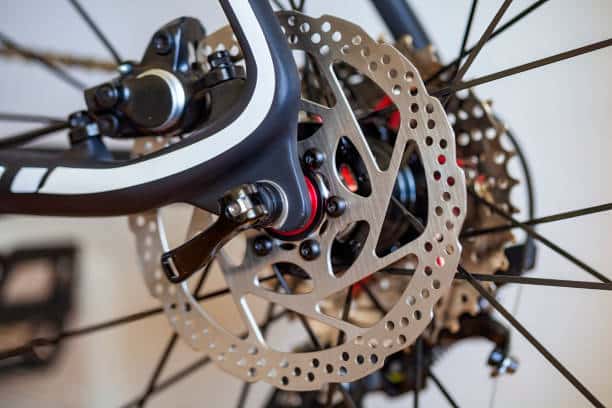
Brake rotors, also called discs, are the circular metal components attached to the wheel hub that the brake pads clamp onto to slow the wheel. Rotors are typically made of stainless steel or aluminum and come in various sizes and designs to suit different riding styles and conditions.
- Rotor size: Rotor size is measured in millimeters and refers to the diameter of the rotor. Common sizes include 160mm, 180mm, and 203mm. Larger rotors provide more braking power and better heat dissipation, making them suitable for heavier e-bikes or more demanding riding conditions. However, larger rotors also add weight to the bike.
- Rotor design: Rotors can be solid or vented, with vented designs featuring cut-outs or channels to improve heat dissipation. Some rotors also have a two-piece construction, with an aluminum spider and a stainless steel braking surface, to reduce weight while maintaining durability.
When selecting a rotor size and design, consider your e-bike’s weight, intended use, and the terrain you’ll be riding on. Consult your brake manufacturer’s recommendations for compatible rotor sizes and always use rotors that are designed for your specific brake system.
Brake Fluid
In hydraulic disc brake systems, brake fluid is the medium that transmits force from the lever to the caliper. Brake fluid is a specially formulated liquid that is incompressible, allowing it to efficiently transfer pressure through the hydraulic system.
There are several types of brake fluid, each with its own properties and boiling points:
The most common types are DOT (Department of Transportation) fluids, such as DOT 3, DOT 4, and DOT 5.1, and mineral oil. It’s crucial to use the type of fluid specified by your brake manufacturer, as using the wrong fluid can cause damage to the seals and other components in the system.
Brake fluid is hygroscopic, meaning it absorbs moisture from the air over time. As moisture accumulates in the fluid, it lowers the fluid’s boiling point and can lead to a spongy feel at the lever and reduced braking performance. To maintain optimal performance, it’s essential to periodically replace the brake fluid and bleed the system to remove any air bubbles or contaminated fluid.
Brake Maintenance and Adjustment
Proper maintenance and adjustment of your e-bike brakes are essential for ensuring consistent performance and longevity. Here are some key maintenance tasks and considerations:
Brake Pad Wear and Replacement
Brake pads are a consumable component and will wear down over time with regular use. It’s essential to regularly inspect your brake pads for wear and replace them when they reach the minimum thickness indicated by the manufacturer, which is usually around 1mm.Worn brake pads can lead to reduced braking power, increased lever travel, and damage to the rotor.
If you allow your pads to wear past the minimum thickness, the metal backing plate may come into contact with the rotor, causing gouges or warping that can be expensive to repair or replace.
When replacing brake pads, always use the correct type for your brake system. Consult your brake manufacturer’s recommendations or visit a reputable bike shop for assistance in selecting the right pads. Follow the manufacturer’s instructions for installation and be sure to properly bed-in the new pads to ensure optimal performance and longevity.
Bedding-in, also known as burnishing, is the process of gradually breaking in new brake pads and rotors to ensure even wear and optimal braking performance. To bed-in new pads, perform a series of controlled stops from moderate speed, allowing the brakes to cool between each stop. This process helps transfer a thin layer of pad material onto the rotor surface, improving brake bite and reducing the likelihood of uneven pad wear or vibration.
Rotor Cleaning and Truing
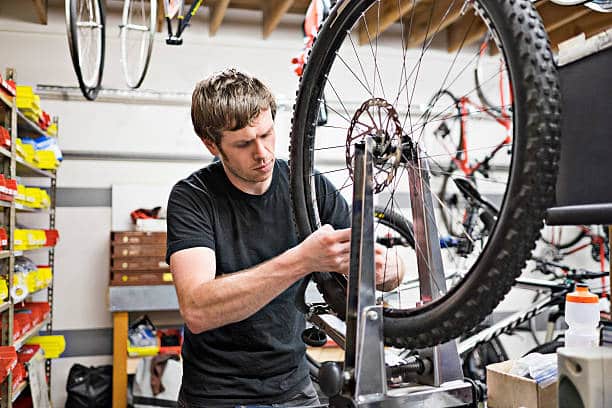
Over time, brake rotors can accumulate dirt, grime, and brake pad residue, which can lead to reduced braking performance, squealing, or vibration. To maintain optimal braking performance, it’s important to periodically clean your rotors using a dedicated brake cleaner or isopropyl alcohol.
Avoid using harsh chemicals or abrasive materials, as these can damage the rotor surface or leave residue that can contaminate the brake pads. Always clean rotors in a well-ventilated area and wear gloves to protect your skin from the cleaning agents.
In some cases, rotors may become bent or warped due to impact, excessive heat, or improper installation. A warped rotor can cause brake vibration, pulsing, or uneven pad wear. If you suspect your rotor is warped, you can use a rotor truing tool to gently bend it back into shape.
Rotor truing is a delicate process that requires patience and a steady hand. If you are not confident in your ability to true a rotor, it’s best to seek the assistance of a qualified bike mechanic. In some cases, severely damaged rotors may need to be replaced entirely to ensure safe and reliable braking performance.
Cable Tension and Lubrication (Mechanical Brakes)
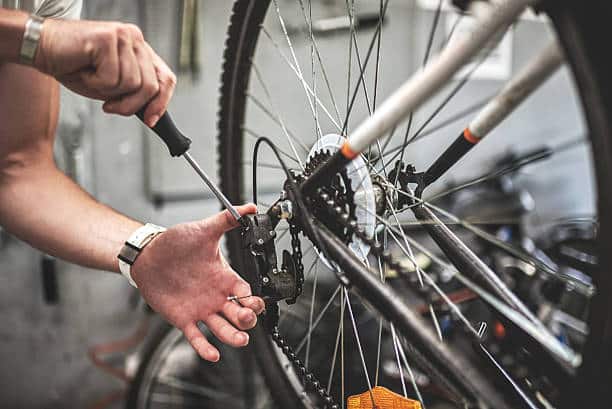
For mechanical disc brakes, proper cable tension is essential for optimal braking performance. Over time, cables can stretch, leading to increased lever travel and a spongy feel.
Adjusting Cable Tension:
- Use the barrel adjuster at the caliper or lever to tighten or loosen the cable as needed.
- Aim for a firm lever feel with minimal free stroke (the distance the lever travels before the pads engage the rotor).
- If you find that you need to frequently adjust cable tension, it may be time to replace the cable and housing altogether.
Lubricating Cables and Housing:
- To ensure smooth cable operation and prevent corrosion, periodically lubricate the cable and housing with a light, penetrating oil designed for brake systems.
- Apply a small amount of lubricant to the cable where it enters the housing.
- Work the lever a few times to distribute the lubricant along the length of the cable.
- Avoid over-lubricating the cable, as this can attract dirt and grime that can eventually lead to cable binding or contamination of the brake pads.
Remember:
- Proper cable tension is crucial for optimal braking performance.
- Regular lubrication helps maintain smooth cable operation and prevents corrosion.
- Use a light, penetrating oil specifically designed for brake systems.
- Be cautious not to over-lubricate, as this can lead to dirt accumulation and brake pad contamination.
By following these guidelines, you can ensure that your mechanical disc brakes maintain proper cable tension and smooth operation, resulting in reliable and consistent braking performance.
Brake Fluid Maintenance (Hydraulic Brakes)
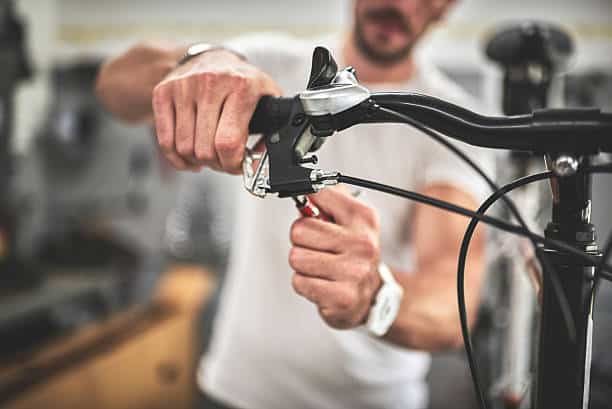
For hydraulic disc brakes, maintaining the brake fluid level and quality is essential for optimal performance and safety. Over time, brake fluid can absorb moisture from the air, leading to a lowered boiling point and reduced braking efficiency.
To check the brake fluid level, locate the master cylinder reservoir on the brake lever assembly. Most reservoirs have a transparent window or a minimum/maximum fill line that indicates the proper fluid level. If the fluid level is low, carefully add the manufacturer-specified brake fluid until it reaches the appropriate level.
When adding brake fluid, be sure to use a clean, lint-free cloth to wipe away any dirt or debris from the reservoir cap and surrounding area to prevent contamination.
Always use the brake fluid type specified by the manufacturer, as different types of fluid are not compatible and can cause damage to the system.In addition to maintaining the fluid level, it’s also important to periodically bleed the brake system to remove any air bubbles or contaminated fluid.
Air bubbles in the system can cause a spongy lever feel and reduced braking power, while contaminated fluid can lead to corrosion and damage to internal components.Bleeding hydraulic brakes involves forcing fresh fluid through the system from the master cylinder to the caliper, displacing any air bubbles or old fluid along the way.
This process typically requires a bleeding kit specific to your brake system and can be somewhat technical. If you are not comfortable bleeding your brakes, it’s best to have this service performed by a qualified bike mechanic.
As a general rule, it’s a good idea to have your hydraulic brakes bled at least once a year or whenever you notice a change in lever feel or braking performance. More frequent bleeding may be necessary if you ride in wet or muddy conditions, as these environments can accelerate fluid contamination.
Brake Safety and Performance Tips
To maximize your e-bike braking performance and safety, consider the following tips:
- Use both brakes simultaneously: When slowing down or coming to a stop, engage both the front and rear brakes simultaneously to distribute the braking force evenly and maintain stability. Avoid relying solely on one brake, as this can lead to skidding or loss of control.
- Modulate your braking: Apply the brakes smoothly and progressively, especially in wet or slippery conditions. Sudden, hard braking can cause the wheels to lock up and skid, reducing your control over the bike. Practice modulating your braking force to match the terrain and conditions.
- Anticipate stops: Always look ahead and anticipate when you’ll need to slow down or stop. This will give you ample time to react and brake smoothly, reducing the likelihood of sudden, hard braking that can lead to skidding or loss of control.
- Maintain proper tire pressure: Underinflated tires can reduce braking efficiency and stability, as they have a larger contact patch with the ground and are more prone to deformation under load. Always maintain your tires at the manufacturer-recommended pressure for optimal braking performance and overall ride quality.
- Adjust brake lever reach: Ensure that your brake levers are positioned for comfortable and easy access. Most brake levers feature an adjustable reach that allows you to customize the distance between the lever and the handlebar. Properly adjusted levers will enable you to apply the brakes quickly and confidently without straining your hands or fingers.
- Inspect your brakes regularly: Make a habit of inspecting your brake system before each ride. Check the brake pads for wear, the rotors for any signs of damage or contamination, and the cables or hoses for fraying or leaks. Address any issues promptly to ensure reliable braking performance and to prevent more serious problems from developing.
- Practice emergency braking: In a controlled environment, practice emergency braking to familiarize yourself with your e-bike’s braking capabilities and to develop proper technique. Find a safe, open area and perform a series of hard stops from various speeds, paying attention to your body position and the feedback from the brakes. Regularly practicing emergency braking will help you react more effectively in real-world situations.
Advanced Braking Technologies
As e-bike technology continues to evolve, manufacturers are introducing advanced braking features to enhance performance and safety. Some of these include:
Regenerative Braking
Regenerative braking systems use the e-bike’s motor to convert kinetic energy into electrical energy during braking, recharging the battery and extending the bike’s range. When the rider applies the brakes, the motor acts as a generator, creating resistance that slows the bike down while also producing electricity to top off the battery.
While regenerative braking is not as efficient as regenerative braking in electric cars, it can still provide a small but noticeable boost to an e-bike’s battery life, particularly in stop-and-go riding conditions or on long descents.
It’s important to note that regenerative braking is not a substitute for traditional friction brakes, but rather a complementary technology. E-bikes equipped with regenerative braking still require mechanical or hydraulic disc brakes for reliable stopping power and safety.
Anti-Lock Braking Systems (ABS)
Anti-lock braking systems, or ABS, are designed to prevent the wheels from locking up during hard braking, maintaining traction and stability. When the rider applies the brakes forcefully, sensors detect if one or both wheels are about to lock up and rapidly modulate the braking force to keep the wheels rotating.
ABS technology has been widely used in automobiles and motorcycles for decades, and is now making its way into the e-bike market. E-bikes equipped with ABS can provide an extra layer of safety and control, particularly in wet or slippery conditions or for less experienced riders who may be prone to grabbing the brakes too aggressively.
However, ABS does add complexity and weight to the braking system, and may require more frequent maintenance or specialized servicing. As with any advanced technology, it’s essential to carefully consider the benefits and drawbacks of ABS when choosing an e-bike or upgrading your existing braking system.
Brake-by-Wire Systems
Brake-by-wire systems replace traditional mechanical or hydraulic connections between the brake levers and calipers with electronic sensors and actuators. When the rider applies the brakes, sensors detect the force and travel of the lever and send an electronic signal to the actuators at the calipers, which then apply the appropriate braking force.
This technology allows for more precise control over braking force and the integration of advanced features like regenerative braking and ABS. Brake-by-wire systems can also provide a more consistent and customizable lever feel, as the electronic actuators are not subject to the same variations in friction and mechanical advantage as traditional cable or hydraulic systems.
However, brake-by-wire systems are still relatively new in the e-bike market and may be more expensive and complex than traditional braking systems. As with any cutting-edge technology, it’s important to carefully research and consider the reliability, serviceability, and long-term performance of brake-by-wire systems before making a decision.
Conclusion
E-bike brakes are a critical component of your electric bicycle, playing a vital role in your safety and riding enjoyment. By understanding the different types of brakes available, their maintenance requirements, and best practices for use, you can make an informed decision when choosing an e-bike or upgrading your existing braking system.
Remember to regularly inspect and maintain your e-bike brakes, paying close attention to pad wear, rotor condition, cable tension, and fluid levels as applicable. By keeping your brakes in top condition and using them properly, you’ll be able to ride with confidence, knowing that you have the stopping power you need when you need it most.
As e-bike technology continues to advance, stay informed about the latest developments in braking systems, such as regenerative braking, ABS, and brake-by-wire. While these innovations may not be necessary for every rider, they can offer enhanced performance, safety, and convenience for those who demand the most from their e-bikes.
Ultimately, the key to mastering your e-bike brakes is a combination of knowledge, regular maintenance, and practice. By following the guidelines and tips outlined in this comprehensive guide, you’ll be well-equipped to tackle any riding situation with confidence, ensuring that your e-bike adventures are both thrilling and safe.
Remember, your brakes are your most important safety feature, so never hesitate to invest time and resources into maintaining and upgrading them as needed. With proper care and attention, your e-bike brakes will provide reliable, confident stopping power for years to come, allowing you to fully enjoy


